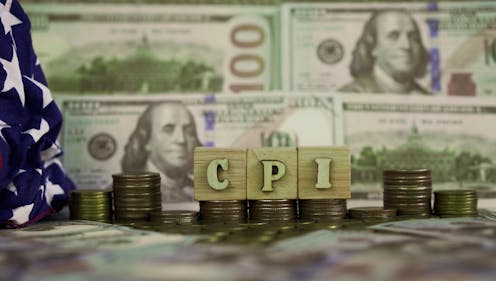US inflation rate fell to 2.4% in September − here’s what that means for interest rates and markets
- Written by Jason Reed, Associate Teaching Professor of Finance, University of Notre Dame

It wasn’t that long ago that the Federal Reserve, the central bank for the United States, was worrying that annual inflation would surpass 9% in the middle of 2022[1]. The U.S. economy hadn’t seen prices rise that fast since the 1980s, and most everyone feared that a series of interest rate hikes would plunge the economy into a recession.
What a difference two years can make.
Inflation cooled[2] to 2.4% in September 2024, according to consumer price index data released by the Labor Department on Oct. 10. That’s down from 2.5% the previous month and in line with market expectations of 2.3% to 2.4%[3]. The inflation rate peaked at 8.9% in June 2022 – a 41-year high[4].
The news brings the Fed – and its chair, Jerome Powell – much closer to reaching its 2% inflation target[5]. It also marks the fourth straight month that year-over-year price changes have been below 3% and the third consecutive month of declining inflation rates.
Speaking as an economist and finance professor[6], I think this could be a big deal for the Federal Reserve, which next meets – and could again cut interest rates – in November.
Fodder for another rate cut?
The Fed has what’s called a dual mandate[7]: It pursues both low inflation and stable employment, two goals that can sometimes be at odds. Cutting interest rates can help employment but worsen inflation, while hiking them can do the opposite.
Since inflation started to take off[8] during the COVID-19 pandemic, Fed officials have emphasized that their job isn’t done until price increases are back down to the 2% target.
But in light of recent labor market news, Powell and his colleagues have changed their messaging a bit[9]. This indicates that the upside risks of inflation are lower than the risks associated with a weakening labor market.
And in September, the Fed slashed the federal funds rate[10] by 0.5 percentage point, or 50 basis points – the first cut since it began hiking rates in March 2022. The move came as unemployment had ticked up to 4.3% in July[11], job openings plummeted[12] and broader labor markets weakened.
Increasingly optimistic markets
Equity markets rallied[13] on the news of the September rate cut. Investors believe reductions in the federal funds rate, which is a prime rate that helps to dictate mortgage rates, auto loans, credit card rates and home equity lines of credit, will spur increases in investment and consumption, guiding the economy to a so-called soft landing[14] instead of a recession.
After that meeting, most members of the Federal Reserve Board indicated they would also favor cutting rates[15] by 25 basis points at each of their upcoming November and December meetings[16].
Between today’s inflation news and the unexpectedly sunny jobs report[17] on Oct. 4, investors and markets have a lot of news to digest as they consider what path interest rates will take in the months ahead. Many continue to believe that we may well see two 25-basis-point cuts by the end of 2024[18] – and so do I.
References
- ^ middle of 2022 (fred.stlouisfed.org)
- ^ Inflation cooled (www.wsj.com)
- ^ 2.3% to 2.4% (us.econoday.com)
- ^ a 41-year high (www.wsj.com)
- ^ 2% inflation target (theconversation.com)
- ^ economist and finance professor (mendoza.nd.edu)
- ^ dual mandate (www.stlouisfed.org)
- ^ started to take off (www.bls.gov)
- ^ changed their messaging a bit (www.federalreserve.gov)
- ^ Fed slashed the federal funds rate (www.federalreserve.gov)
- ^ 4.3% in July (fred.stlouisfed.org)
- ^ job openings plummeted (data.bls.gov)
- ^ Equity markets rallied (www.nytimes.com)
- ^ soft landing (www.investopedia.com)
- ^ also favor cutting rates (www.federalreserve.gov)
- ^ November and December meetings (fred.stlouisfed.org)
- ^ unexpectedly sunny jobs report (www.reuters.com)
- ^ two 25-basis-point cuts by the end of 2024 (www.cmegroup.com)
Authors: Jason Reed, Associate Teaching Professor of Finance, University of Notre Dame

